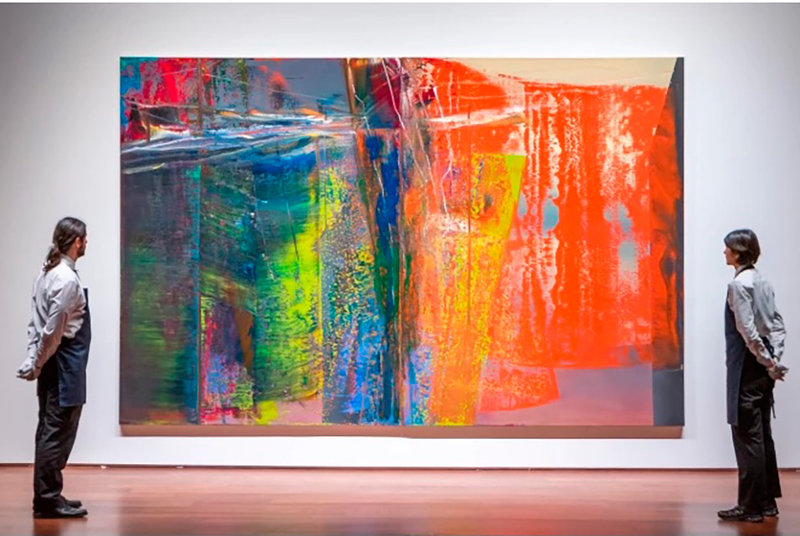
Gerhard Richter - the most expensive living artist in Europe
ArtWizard 02.10.2023
On 10 February 2015 at the auction Sotheby's in London Abstraktes Bild 1986 painting by Gerhard Richter was sold for 46.3 million dollars and turned his creator into the most expensive of the living artists in Europe, whose works are put up for auction! Richter's work captured the attention of all the bidders at the auction. It seemed that his market is experiencing a recession after a sharp jump in prices for abstract decorative works. But, as it turned out, it is not so. According to Sotheby's data, for Abstraktes Bild 1986 fought buyers from three countries. The preliminary estimate for the canvas was $21.3 million to $30.5 million. This painting, painted in 1986, is one of Richter's largest abstract works and one of the first to be executed using a scraper as a tool.
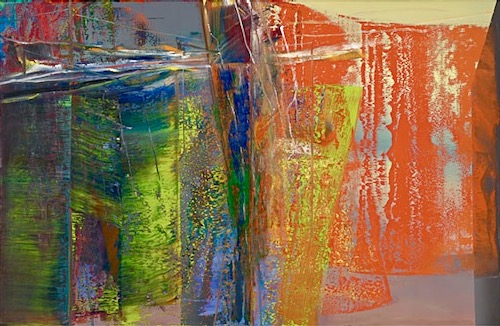
Gerhard Richter, Abstraktes Bild, 1986
Photo Credit: The official website of Gerhard Richter
Gerhard Richter, born on 9 February 1932 in Dresden, GDR, the son of a high school teacher and a book seller. His interest in art began to take shape after World War II. His mother encouraged her son's desire to read, and it was the huge stock of illustrated books that encouraged the boy to paint. In an interview, the artist said that he learnt about art "from books and from little folios with art prints [...] I remember Diego Velázquez, Albrecht Dürer, Lovis Corinth". One of his earliest sketches, made at the age of 14, was a nude figure copied from a book, to which his parents reacted with pride and embarrassment. After leaving school, Richter worked at various jobs as a photo lab assistant and as an advertising and enterprise artist, and was also a stage designer. In 1951, Richter enrolled at the Dresden Academy of Fine Arts / Hochschule für Bildende Künste Dresden. "It was a very traditional, academic school where we learnt from plaster copies and nude models," he recalled. - Socialist Realism was at the forefront, and the Dresden Academy was particularly strict in this respect." The study of modernist experiments was forbidden, but there were exceptions. Pablo Picasso and Renato Guttuso, for example, were tolerated by the authorities for their outspoken support of communism. In 1956, while still a student, he created the mural Lebensfreude for the German Hygiene Museum / Deutsches Hygiene-Museum in Dresden. After his defection to the west, and his subsequent criticism of the art produced in his native East Germany, the mural was painted over by the authorities in 1979. A turning point in Richter's career was a visit to documenta II in Kassel in 1959. There he saw the works of Ernst Wilhelm Nye, Jackson Pollock, Lucio Fontana and Jean Fautrier as "expressions of a completely different and entirely new content" and realised the creative inhibitions imposed on him.
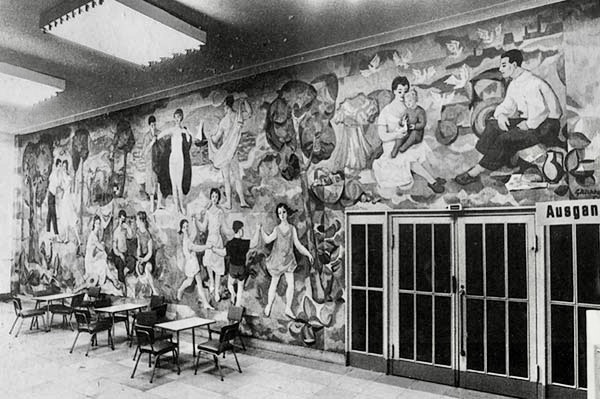
Gerhard Richter, Lebensfreude, 1956 - Hygienemuseums, Dresdner (not on display)
Photo Credit: The official website of Gerhard Richter
In 1961 Gerhard Richter decided to leave the GDR, despite recognition and relative safety. "After all, I was relatively well off in the GDR. With the position of 'muralist', I was not subject to accusations of formalism like panellists and received commissions to create murals, i.e. I could make a living out of it and remain reasonably untouchable by the system. But this was an unsatisfactory prospect, above all because the paintings that I did as usual on the side, and which were my real concern, were getting worse and worse, more and more unfree and false" - quoted in Dietmar Elger's book "Gerhard Richter. The Artist", Cologne 2008, p. 39. Gerhard Richter managed to escape to West Germany without any problems, but his artistic escape from the "idealism" of socialism was not an easy ordeal. Since the train from Moscow to Dresden stopped in West Berlin, the artist travelled to Moscow and Leningrad (now St. Petersburg) on 30 March 1961, and on the way back he stashed his suitcases in West Berlin and then picked up his wife Ema in Dresden.
In April 1961, Richter travelled to the booming and artistically tolerant Düsseldorf, where he lived with Reinhard Graner. His first creative contact was the independent artist Peter Brüning, to whom he showed his portfolio. Contrary to expectations, Brüning praised his figurative paintings rather than Richter's abstract experiments. Although Richter had already graduated from the academy in Dresden, he decided to enrol at the State Academy of Fine Arts in Düsseldorf / Kunstakademie Düsseldorf. "I tried everything I could," he says, describing his work during that period as "changing in style between Dubuffet, Giacometti, Tapies and many others. In search of work and inspiration and began his training under Ferdinand Macketanz. This decision proved to be the right one "By the beginning of the term in February 1962, I was already drawing so much that I caused a stir. Practically the entire auditorium was occupied by me, and I had it papered to the ceiling with paintings." Richter quickly mastered the expression of inner states of mind evidenced in his earliest informal paintings. During this period Jean Dubuffet, Jean Fautrier, Lucio Fontana and Francis Bacon turned into the most important sources of inspiration. Gerhard Richter turned exclusively to abstract painting for a time, intensively exploring material and surface. Like Fontana, Richter attacked canvases and pierced them. In the present day, the works of this phase are seen as a stroke of artistic liberation, demonstrating the unbridled energy and emotionality of their creator. In February 1962, at the end of term, the artist attracted attention by presenting these works for the first time. This was also the occasion for him to meet Konrad Lueg and Alfred Kuttner. Lueg then persuaded him to join the class of Karl Otto Götz.
"I remember the trip in February 1962, his informal paintings hung in the dark lower corridor of the Academy. But soon he began to paint signal paintings. When Gaul came to visit me at the Academy and looked into my classroom, he was surprised to see, among other things, signal paintings hanging on the wall. He, too, was painting signal pictures at the time and scolded: 'There is hardly anything new in the art world, and this is already practised at the Academy'." - Karl Otto Goetz.
From 8 to 30 September 1962 Gerhard Richter exhibited 20 oil paintings, four textile works, four subject drawings (unspecified), nine lacquer works and two groups of 26 white and 23 yellow drawings from the informal phase of his work at the Galerie Junge Kunst in Fulda. The exhibition included a recording of the artist discussing the fairy tale "The Emperor's New Clothes" / "Des Kaisers neue Kleider", which, however, ended with a recommendation to punish a child for not understanding anything about art. He made the presentation together with Manfred Kuttner and was organised by Franz Erhard Walther. To the approved titles - Exzeß, Narbe, Resection, Verwundung or Aggression - Richter added work numbers, which showed that he had created more than 80 works. The catalogue text with the author Alexander Delsenroth and is the first art historian's assessment of the artist's paintings: "Richter's works are emotional in nature. He allows the event of his inner world to take place in the pictorial space or brings it beyond the surface into the background. The economy of means only makes this process more insistent and intensifies its seriousness, whether the design is in black, grey, white or green, where the shifting of the 'horizon' has a redemptive or crushing effect." Until this point, it was believed that after the presentation the artist burned all his paintings to start a new life, but he subsequently became acquainted with American Pop Art and began painting from media images in the autumn of 1962.
During his studies at the Düsseldorf Academy, Gerhard Richter met fellow students Konrad Lüg, Sigmar Polke and Blinky Palermo. Already in 1962, he began to incorporate media images he found in private photo albums, newspapers, magazines, advertising brochures and illustrated books into his paintings. His first photographic painting is Tisch, 1962, the model for which he found in the Italian magazine "domus" of August 1956. Richter says he "didn't really like his first photographic painting..., so I smudged it like that." His goal was to "create artless art out of something artless," as he himself says later. For the first time, the artist exhibited new, model-based photographic paintings at a term exhibition at the Academy in February 1963. In the same year he became friends with Günther Uecker, who had already been using nails to create rhythmic structures on the predominantly white surfaces of his paintings since 1957. Despite their different artistic views, they got on well together and when a room became available next door to Uecker's studio on Fürstenwall 204, he arranged for Richter to use it. The artist thus moved into his first studio of his own (outside the academy), which he used until 1970.

Gerhard Richter, Tisch, 1962
Photo Credit: The official website of Gerhard Richter
From 1963 onwards, Gerhard Richter, in an effort to paint in opposition to the innovation of modernism experimented with monochrome painting, blurred, indistinct portraits. He still believes today that "when random details disappear due to the blurring effect, the portrait appears clearer, but at the same time more mysterious". To this must be added the fleeting nature of perception and memory. With the term "capitalist realism", which he coined with Kuttner, Lüg and Polke for the exhibition at Kaiserstraße 31A, he responded to American Pop Art, the work of Roy Lichtenstein as well as socialist realism. Although Richter admired the radicalism of the Pop artists, he also regarded their work with a slight unease.
Heiner Friedrich met Richter through Kasper König, who at the time was still studying the history of kissing at The Courtauld Institute of Art in London. During his first visit to Richter's studio, the gallerist organised an exhibition in Munich from 10.06. to 10.07.1964 at the Galerie Friedrich+Dahlem, where Richter was able to show 14 paintings. In July of the same year, he left the Düsseldorf Academy without graduating or receiving the title of master student, and his contacts with Konrad Lüg and Sigmar Polke played an extremely important role in the following years in redefining painting in opposition to photography.
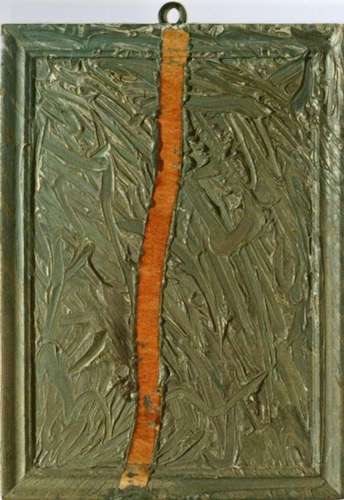
Gerhard Richter, Abstraktes Bild, 1964
Photo Credit: The official website of Gerhard Richter
Richter's paintings began to show an interest in current events, consumer society, mass media and popular culture. In the early works that launched the artist's professional career, a decisive breakthrough was the use of photographic images, which had previously been unthinkable for him and for academic painting. It was this approach that marked his work in the following decades.
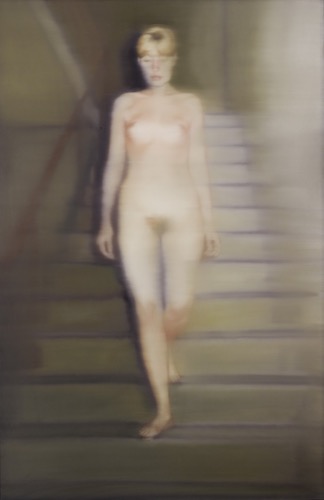
Gerhard Richter, Ema (Akt auf einer Treppe), 1966
Photo Credit: The official website of Gerhard Richter
The colour panels with randomly arranged coloured areas (from 1966), curtains (1965), cityscapes (1968) and Atmo-Romantic landscapes (1968) created in the second half of the 1960s show how actively Gerhard Richter worked with minimal art and conceptual art and transferred their results into his painting. The year 1966 proved to be a key year for Richter. He began to exhibit not only in Germany but also abroad and created one of his most famous works, Ema (Akt auf einer Treppe) from a colour Polaroid photograph. The model was the artist's wife Marianne (Ema) Eufinger. Then he started a series of geometric abstractions called Farbtafel (1, 2, 3, 4). Geometric elements became firmly established in his work and reappeared, for example in the design of a stained-glass window in Cologne Cathedral in 2007.
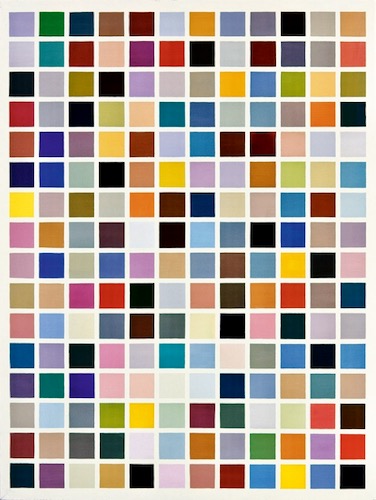
Gerhard Richter, 192 Farben, 1966
Photo Credit: The official website of Gerhard Richter
